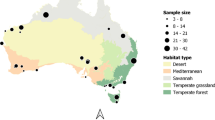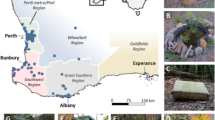Abstract
Identifying cues used by animals to select habitat offers insights into ecological trade-offs-often, contrasting choices amongst physical environment to meet physiological demands, food/other resources and predator avoidance. We examined the relative influence of food and refuge on occurrence of Royle’s pika, a common high-altitude prey in western Himalaya. We sampled distribution of rock with different crevices size (anti-predation refuge), and vegetation cover (food) in 0.25-ha plots at 20 pika occupied sites each paired with a putative (talus habitat) but unoccupied site along 1080-m elevation gradient. We used logistic regression and information-theoretic approach to test the effects of these factors on habitat selection. We found that pika occurrence was determined by rock cover with small crevices (AICc-wt summation = 0.98 R 2 = 0.77) in a positive way (β = 0.16 ± 0.03), whereas negligibly influenced by vegetation covers (AICc-wt range 0.01–0.21). Model incorporating rock cover with small crevices could accurately predict pika occurrence (93 % area under ROC curve). Since this species inhabit open habitats with high predation risk and heat stress, abundant rock cover with small crevices offers critical escape from predators apart from providing thermal refuge since temperature inside rock crevices are usually moderate compared to ambient conditions. It simultaneously allows animals to access larger foraging areas that perhaps reduce their dependency on local food availability. Thus, we demonstrate the relative importance of refuge over food in microhabitat selection by pika and highlight that concurrent large-scale rock extraction for developmental activities can adversely affect pika distribution.



Similar content being viewed by others
References
Abrams PA (1982) Functional responses of optimal foragers. Am Nat 120:381–390
Abrams PA (1989) Decreasing functional responses as a result of adaptive consumer behaviour. Evol Ecol 3:95–114
Adhikari BS, Rawat GS, Bhattacharyya S, Rai ID, Bharati RR (2012) Ecological assessment of Timberlineecotone with special reference to anthropogenic pressure and climatic variability. Final report, Wildlife Institute of India, Dehradun,India
Alfred JRB, Das AK, Sanyal AK (2006) Animals of India: Mammals. Zoological Survey of India, India
Aryal A, Sathyakumar S, Kreigenhofer B (2010) Opportunistic animal’s diet depend on prey availability: spring dietary composition of the red fox (Vulpes vulpes) in the Dhorpatan hunting reserve Nepal. J Ecotoxicol Environ Monit 2:59–63
Baasch DM, Tyre AJ, Millspaugh JJ, Hygnstrom SE, Vercauteren KC (2010) An evaluation of three statistical methods used to model resource selection. Ecol Model 221:565–574
Beever EA, Brussard PF, Berger J (2003) Patterns of apparent extirpation among isolated populations of pikas (Ochotona princeps) in the Great Basin. J Mammal 84:37–54
Beever EA, Ray C, Mote PW, Wilkening JL (2010) Testing alternative models of climate-mediated extirpations. Ecol Appl 20:164–178
Bhattacharyya S (2013) Habitat ecology of Royle’s pika (Ochotona roylei) along altitudinal gradient with special reference foraging behaviour in western Himalaya. Ph.D. Dissertation, Saurashtra University, India
Bhattacharyya S, Adhikari BS, Rawat GS (2009) Abundance of Royle’s pika (Ochotona roylei) along an altitudinal gradient in Uttarakhand, Western Himalaya. Ital J Mammal 20:111–119
Bhattacharyya S, Adhikari BS, Rawat GS (2013) Forage selection by Royle’s pika(Ochotona roylei) in the western Himalaya, India. Zoology 116:300–306
Bhattacharyya S, Adhikari BS, Rawat GS (2014) Influence of snow, food, and rock cover on Royle’s pika abundance in Western Himalaya. Arc Antarc Alp Res 46:558–567
Broadbooks HE (1965) Ecology and distribution of pikas of Washington and Alaska. Am Midl Nat 73:299–335
Brown JS (1988) Patch use as an indicator of habitat preference, predation risk, and competition. Behav Ecol Sociobiol 22:37–47
Brown JS (1989) Desert rodent community structure: a test of four mechanisms of coexistence. EcolMonogr 59:1–20
Brown JS (1998) Game theory and habitat selection. In: Dugatkin LA, Hudson KR (eds) Game theory and animal behavior. Oxford University Press, New York, pp 188–220
Bunnell SD, Johnson DR (1974) Physical factors affecting pika density and dispersal. J Mammal 55:866–869
Burnham KP, Anderson DR (2002) Model selection and multimodal inference. Springer-Verlag, New York
Chakraborty S, Bhattacharyya TP, Srinvasulu C, Venkataraman M, Goonatilake WLDPTS de A, Sechrest W, Daniel BA (2005)Ochotona roylei (Ogilby, 1839). In: Molur S, Srinivasulu C, Srinivasulu B, Walker S, Nameer PO, Ravikumar L (eds). Status of South Asian Non-volant Small Mammals: Conservation Assessment and Management Plan (C.A.M.P.) Workshop Report. Coimbatore, India, pp.618
Chivers DP, Smith RJF (1998) Chemical alarm signaling in aquatic predator-prey systems: a review and prospectus. Ecoscience 5:338–352
Dearing MD (1997) The function of haypiles of pikas (Ochotona princeps). J Mammal 78:1156–1163
DeWitt TJ, Sih A, Hucko JA (1999) Trait compensation and co specialization in a freshwater snail: size, shape and anti predator behaviour. Anim Behav 58:397–407
Erb LP, Ray C, Guralnick R (2011) On the generality of a climate-mediated shift in the distribution of the American pika (Ochotona princeps). Ecology 92:1730–1735
Franken RJ, Hik DS (2004) Influence of habitat quality, patch size and connectivity on colonization and extinction dynamics of collared pikas (Ochotona collaris). J Anim Ecol 73:889–896
Gause GF, Smaragdova NP, Witt AA (1936) Further studies of interaction between predators and prey. J Anim Ecol 5:1–18
Graham MH (2003) Confronting multicollinearity in ecological multiple regression. Ecology 84:2809–2815
Grayson DK (2006) The Late Quaternary biogeographic histories of some Great Basin mammals (western USA). Quaternary Sci Rev 25:2964–2991
Green MJB (1985) Aspects of the ecologyof the Himalayan musk deer. Ph.D. Dissertation. Department of Zoology, Cambridge University U.K
Holmes WG (1991) Predator risk affects foraging behaviour of pikas: observational and experimental evidence. Animal Behav 42:111–119
Hoverman JT, Auld JR, Relyea RA (2005) Putting prey back together again: integrating predator-induced behaviour, morphology and life history. Oecologia 144:481–491
Huntly NJ, Smith AT, Ivins BL (1986) Foraging behavior of the pika (Ochotona princeps) with comparisons of grazing versus haying. J Mammal 67:139–148
Johnson DH (1980) The comparison of usage and availability measurements for evaluating resource preference. Ecology 61:65–71
Kaufman DW, Fleharty ED (1974) Habitat selection by some species of rodents in north-central Kansas. Southwest Nat 18:443–452
Kawamichi T (1968) Winter behaviour of the Himalayan pika, Ochotona roylei. J. Faculty of Science, Hokkaido University VI. Zoology 16:582–594
Kohler SL (1992) Competition and the structure of a benthic stream community. Ecol Monogr 62:165–188
Kotler BP, Brown JS, Hasson O (1991) Factors affecting gerbil foraging behavior and rates of owl predation. Ecology 72:2249–2260
Kotler BP, Blaustein L, Brown JS (1992) Predator facilitation: the combined effects of snakes and owls on the foraging behaviour of gerbils. Ann Zool Fenn 29:199–206
Krebs JR (1980) Optimal foraging, predation risk and territory defense. Ardea 68:83–90
Krebs CJ (1999) Ecological methodology. Benjamin Cummings, California
Liebold M (1988) Habitat structure and species interactions in plankton communities of stratified lakes.Ph.D. Dissertation, Michigan State University, East Lansing, USA
Lima SL (1998a) Non lethal effects in the ecology of predator-prey interactions. Bio Sci 48:25–34
Lima SL (1998b) Stress and decision making under the risk of predation: recent developments from behavioral, reproductive, and ecological perspectives. Stress Behav 27:215–290
Lima SL, Dill LM (1990) Behavioral decisions made under the risk of predation: a review and prospectus. Can J Zool 68:619–640
Manly BFJ, McDonald LL, Thomas DL, McDonald TL, Erickson WP (2002) Resource selection by animals: statistical design and analysis for field studies. Chapman and Hall, London
Manning T, Hagar JC (2011) Use of non alpine anthropogenic habitats by American Pikas (Ochotona princeps) in Western Oregon. Western North Am Nat 71:106–112
Millar CI, Westfall RD (2010) Distribution and climatic relationships of the American pika (Ochotona princeps) in the Sierra Nevada and western Great Basin, U.S.A.; periglacial landforms as refugia in warming climates. Arc Antarc Alp Res 42:76–88
Miller DH, Getz LL (1976) Factors influencing local distribution and species diversity of forest small mammals in New England. Can J Zool 55:806–814
Morrison S, Barton L, Caputa P, Hik DS (2004) Forage selection by collared pikas, Ochotona collaris, under varying degrees. Can J Zool 82:533–540
Mortiz C, Patton JL, Conroy CJ, Parra JL, White GC, Beissinger SR (2008) Impact of a century of climate change on small-mammal communities in Yosemite National Park, USA. Science 322:261–264
Murdoch WW (1969) Switching in general predators: experiments on predator specificity and stability of prey populations. Ecol Mono 39:335–354
Nonacs P, Dill LM (1990) Mortality risk versus food quality trade-offs in a common currency: Ant patch preferences. Ecology 71:1886–1892
Peacor SD, Werner EE (2001) The contribution of trait mediated indirect effects to the net effects of a predator. P Natl Acad SciUSA 98:3904–3908
Possardt EE, Dodge WE (1978) Stream channelization impacts on songbirds and small mammals in Vermont. Wildlife Soc B6:18–24
Roach WJ, Huntly N, Inouye R (2001) Talus fragmentation mitigates the effects of pikas, Ochotona princeps, on high alpine meadows. Oikos 92:315–324
Roberts TJ (1977) The mammals of Pakistan. Ernest Benn Ltd, London
Rodhouse TJ, Beever EA, Garrett LK, Irvine KM, Jeffress MR, Munts M, Ray C (2010) Distribution of American pikas in a low-elevation lava landscape: conservation implications from the range periphery. J Mammal 91:1287–1299
Sih A (1987) Predators and prey life styles: an evolutionary and ecological overview. In: Kerfoot WC, Sih A (eds) Predation: direct and indirect impacts on aquatic communities. University Press of New England, Hanover, London, p 203
Sih A (1998) Game theory and predator-prey response races. In: Dugatkin LA, Hudson KR (eds) Game theoryand animal behavior. Oxford University Press, New York, pp 221–238
Simpson WG (2009) American pikas inhabit low-elevation sites outside the species’ previously described bioclimatic envelope. West North Am Nat 69:243–250
Smith AT (1974) The distribution and dispersal of pikas: influences of behaviour and climate. Ecology 55:368–376
Smith AT, Weston ML (1990) Ochotona princeps. Mammalian Species 352:1–8
Smith AT, Formozov AN, Hoffmann RS, Changlin Z, Erbajeva MA (1990a)The pikas. In:Chapman JA, Flux JEC (eds.) Rabbits, hares, and pikas, Status survey and conservation action plan.IUCN, Switzerland, pp.14-60
Trenham PC, Koenig WD, Mossman MJ, Stark SL, Jagger LA (2003) Regional dynamics of wetland-breeding frogs and toads: turnover and synchrony. Ecol App 113:1522–1532
Van Hees WWS, Mead BR (2000) Ocular estimates of understory vegetation structure in a Closed Picea glauca/Betula papyrifera forest. J VegSci 11:195–200
Varner J, Dearing MD (2014) The importance of biologically relevant microclimates in habitat suitability assessments. PLoS One 9(8):e104648
Walther GR, Post E, Convey P, Menzel A, Parmesan C, Beebee TJC, Fromentin JM, Guldberg OH, Bairlein F (2002) Ecological responses to recent climate change. Nature 416:389–395
Werner EE, Peacor SD (2003) A review of trait-mediatedindirect interactions in ecological communities. Ecology 84:1083–1100
Acknowledgments
We are thankful to the Director, Dean and Research Coordinator of Wildlife Institute of India, Dehradun for providing financial and logistic support, Council of Scientific and Industrial Research (CSIR) for providing grant to the first author during manuscript writing, and Uttarakhand State Forest Department for providing necessary field permits for this study. We also thank Gabbar Singh Bisht for his sincere field effort, Professor Ille Gebeshuber (AuthorAID mentor) for assistance in language improvement, and M.A. Owen for his technical inputs to the manuscript.
Author information
Authors and Affiliations
Corresponding author
Additional information
Communicated by: Karol Zub
Electronic supplementary material
Rights and permissions
About this article
Cite this article
Bhattacharyya, S., Dutta, S., Adhikari, B.S. et al. Presence of a small mammalian prey species in open habitat is dependent on refuge availability. Mamm Res 60, 293–300 (2015). https://doi.org/10.1007/s13364-015-0234-0
Received:
Accepted:
Published:
Issue Date:
DOI: https://doi.org/10.1007/s13364-015-0234-0




